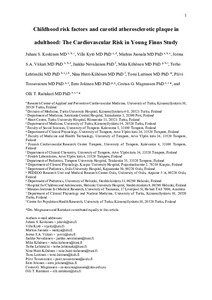Childhood risk factors and carotid atherosclerotic plaque in adulthood: The Cardiovascular Risk in Young Finns Study
Tossavainen P; Hutri-Kähönen N; Magnussen CG; Kytö V; Raitakari OT; Kähönen M; Jokinen E; Koskinen JS; Laitinen T; Lehtimäki T; Nevalainen J; Juonala M; Viikari JSA
https://urn.fi/URN:NBN:fi-fe2021042823778
Tiivistelmä
BACKGROUND AND AIMS:
Carotid plaque is a specific sign of atherosclerosis and adults with carotid plaque are at increased risk for cardiovascular outcomes. Atherosclerosis has roots in childhood and pediatric guidelines provide cut-off values for cardiovascular risk factors. However, it is unknown whether these cut-offs predict adulthood advanced atherosclerosis.
METHODS:
The Cardiovascular Risk in Young Finns Study is a follow-up of children that begun in 1980 when 2653 participants with data for the present analyses were aged 3-18 years. In 2001 and 2007 follow-ups, in addition to adulthood cardiovascular risk factors, carotid ultrasound data was collected. Long-term burden, as the area under the curve, was evaluated for childhood (6-18 years) risk factors. To study the associations of guideline-based cut-offs with carotid plaque, both childhood and adult risk factors were classified according to clinical practice guidelines.
RESULTS:
Carotid plaque, defined as a focal structure of the arterial wall protruding into lumen >50% compared to adjacent intima-media thickness, was present in 88 (3.3%) participants. Relative risk for carotid plaque, when adjusted for age and sex, was 3.03 (95% CI, 1.76-5.21) for childhood dyslipidemia, 1.51 (95% CI, 0.99-2.32) for childhood elevated systolic blood pressure, and 1.93 (95% CI, 1.26-2.94) for childhood smoking. Childhood dyslipidemia and smoking remained independent predictors of carotid plaque in models additionally adjusted for adult risk factors and family history of coronary heart disease. Carotid plaque was present in less than 1% of adults with no childhood risk factors.
CONCLUSIONS:
Findings reinforce childhood prevention efforts and demonstrate the utility of guideline-based cut-offs in identifying children at increased risk for adulthood atherosclerosis.
Kokoelmat
- Rinnakkaistallenteet [19207]
